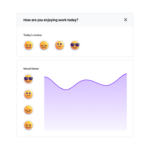Feedback
What is feedback: Meaning, tips and how to use it effectively in all areas of life
Feedback is like a GPS for our decisions and behavior. It shows us whether we are on the right track or if we need to reprogram the route a little. Whether it is a work environment, personal relationships or education, feedback accompanies us everywhere and helps us grow and improve. And let’s face it – who wouldn’t want to be a slightly better version of themselves?
What is feedback?
In a nutshell, it is the exchange of information. We say: You are doing this great! This needs to be fine-tuned. Clear and straightforward. Constructive feedback is the key to change, innovation and better cooperation – at work, at school and at home. At the same time, many people are confused about how to receive or provide it in a way that is useful and does not seem embarrassing.
Here we will show you what feedback is, what its meaning is and why it is so important. But most importantly – how to handle it so that it functions like a well-oiled machine.
Types of Feedback: From Praise to “This Could Be Better”
There’s no such thing as feedback. Different types of feedback play a key role in the development of individuals and teams. Each type has its own place in communication and contributes to overall progress. Let’s take a look at the most common types:
Positive Feedback
Positive feedback focuses on recognizing and appreciating work or behavior well done. It’s that sweet compliment that warms our hearts. “Great job! Your presentation was exactly what we needed.” This kind of feedback boosts motivation and makes us feel valued. And be careful, it’s not just about patting ourselves on the back – positive feedback forces us to keep our standards high!
Negative Feedback
Yeah, this one’s tough – for both parties. But be careful, there’s no need to be afraid of it. When you approach it sensitively and focus on specific situations and behaviors instead of personal criticism, negative feedback can be the best lesson. “Next time, check the numbers in the analysis so we have everything right.” Clear, concise, no digging.
Constructive feedback
The golden mean! It combines praise and criticism. “You did a great job with the analysis, but next time, focus more on the schedule.” This is not just an evaluation – it is a guide to how to improve. The combination of positive and negative information gives us the opportunity to focus on our development. It is a bridge between what we are already doing and what we still have to clean up. Ideal for us!
Why is feedback so essential?
Let’s imagine this: a world without feedback would be like driving a car with your eyes closed. Not much, right? In education, it helps students understand their strengths and weaknesses. Clear and timely feedback helps them know what to focus on. In the workplace, feedback is a driver of performance and collaboration. Whether it’s 360° feedback, satisfaction surveys, or feedback interviews, it always helps improve processes and relationships within a team. In personal relationships, it builds trust and openness. When partners give each other feedback respectfully, they can grow together.
Feedback as a driver of performance and collaboration
In the workplace, feedback is like the lubricant that keeps all parts of a team and processes running smoothly. When provided correctly, it becomes an invaluable tool for growth, improving efficiency, and building trust. All approaches have one thing in common: they help build better communication, strengthen collaboration, and open the door to personal and team growth. Let’s look at a few key concepts that revolve around feedback in the workplace:
1. 360° Feedback
This type of feedback is a bit like a lookout tower – it allows you to see your performance from multiple angles. You get feedback not only from your boss, but also from colleagues, subordinates and sometimes even customers. How does it work? Everyone who works with you provides an anonymous assessment of your behavior, skills and results. This gives you a comprehensive view of your strengths and areas for improvement. 360 feedback is great for developing leadership, identifying hidden talents and improving collaboration. It provides insight into how your surroundings perceive you – and what you can do about it.
2. Satisfaction surveys
These surveys (e.g. Employee Engagement Surveys) focus on how employees feel at work. They ask: Do you feel fulfilled by your work? Do you have enough room for growth? Are you satisfied with the communication within the team? Typically, these are anonymous surveys where employees can openly share their opinions on company culture, leadership, or working conditions. Feedback from these surveys helps companies identify what is working and what needs to be improved—from satisfaction with benefits to team atmosphere. When a company listens, it can prevent turnover and build a more motivated team.
3. Feedback interview
This is feedback on a personal level—and a space for open dialogue between the employee and manager. It can take many forms, from regular one-on-one meetings to annual performance reviews. The manager provides the employee with feedback on their performance while also creating a space for the employee to share their needs, opinions, or concerns. Goals for the future are often set here as well. A feedback interview ensures that everyone knows where they stand. The employee gets a clear idea of what they are doing well and where they can improve. At the same time, they feel like their voice is being heard.
How to give effective feedback?
Here’s where the real magic comes in. Clarity, specificity, and timing are key. But we also have a few specific tricks that will turn you into a feedback master:
Be specific: No vague “That was good.” Instead, try: “Your approach to the client was amazingly empathetic.”
Use structure: The SBI (situation, behavior, impact) model is the right choice! First describe the situation, then the specific behavior, and finally its impact.
Leave room for dialogue: Feedback is not a one-way street. Ask: “How do you see it?”
What to watch out for?
There are some mistakes to avoid when giving feedback:
- Generality: “That was great” may be pleasing, but it won’t help much.
- Personal attacks: We evaluate the behavior, not the person. “That decision wasn’t ideal” is much better than “You’ll never be able to do it.” It’s also a good idea to make sure the recipient doesn’t feel attacked.
- Late responses: Feedback carries the most weight when it is fresh. In that case, it is relevant. Late responses lose their effectiveness.
How to collect feedback? 🛠️
Currently, there are many effective tools and methods for collecting feedback that allow accurate and efficient information gathering. For example, you can use online questionnaires (Google Forms, SurveyMonkey), which are fast and anonymous, simplify the data collection process and provide respondents with easy access. You can also use the evaluation module in Sloneeko. Here, for example, evaluation questionnaires, competency models or performance assessments (OKR, KPI) and development are available.
Focus groups are suitable for qualitative insight, where you can discuss with several people at once. This helps to discover different perspectives and shared opinions. It also allows for deeper understanding and discussion.
A quick and operational solution can be provided by online communication such as Slack, Teams or WhatsApp. The possibility of easy and immediate exchange of opinions is ideal for strengthening teamwork and simplifying communication.
Feedback as the key to growth
Feedback is not just a tool – it is a fundamental building block of personal and professional development. In education, it helps students understand their strengths and areas for improvement, which improves their performance and motivation. In personal relationships, it builds trust, improves communication, and strengthens the bonds that connect us to those we love. And at work, it is literally the fuel that fuels collaboration, increases performance, and fosters innovation. Integrating QR codes into feedback can enhance access and streamline the process for everyone involved.
Feedback, when given correctly—clear, specific, and timely—has incredible power. It not only drives us to perform better, but also enables us to become better partners, colleagues, and leaders. It is a way to change, grow, and adapt to the ever-changing challenges of the world around us.
Remember, feedback is not criticism. It is a gift. A gift that helps us see ourselves through the eyes of others, grow with new perspectives, and build better relationships and results. So don’t be afraid to give it or receive it. Be open, constructive, and specific—and watch as it not only grows your world, but the world of those around you.
Trust box
One of the most effective tools for collecting anonymous feedback is the trust box. This tool allows employees to express their concerns, ideas or complaints without fear of repercussions. Anonymity is key as some employees may be afraid to openly communicate their concerns or suggestions.
Advantages of the trust box:
- Anonymity: Provides employees with a sense of security, which encourages openness and honesty.
- Accessibility: The trust box should be easily accessible to all employees so that they can use it at any time.
- Problem solving: Enables management to identify and solve problems that might otherwise go unnoticed.
At Sloneek, every user has access to a trust box, where they can anonymously leave a message about what is bothering them in the company. This tool is very useful for identifying internal problems and improving the overall atmosphere in the company.
Mood meter
Mood meter is another useful tool for measuring employee satisfaction. It is a simple system that regularly monitors the mood and satisfaction of employees. For example, employees can express how they feel every day or week, allowing management to gain insight into the overall mood of the team.
Advantages of the mood meter:
- Regularity: Allows you to continuously monitor changes in the mood of employees.
- Quick identification of problems: It helps to quickly identify periods when it is necessary to intervene and improve working conditions.
- Fostering openness: Employees have the opportunity to regularly express their feelings, which promotes a culture of openness.
At Sloneek, we offer a mood meter that measures employee satisfaction. This tool helps managers quickly respond to potential problems and create a positive work environment.
Competence model
The competence model is a structured approach to the evaluation and development of employees. Using this model, managers can provide feedback based on specific competencies that are key to a given job position. This approach enables a clear and objective assessment of performance and the identification of areas for improvement.
Advantages of the competency model:
- Clear evaluation criteria: Provides clear and measurable criteria for employee performance evaluation.
- Targeted development: Helps identify specific areas where employees need improvement or additional training.
- Supporting career growth: Enables employees to understand their strengths and weaknesses and plan their career growth.
At Sloneek, we use a competency model that allows team managers to provide feedback to their subordinates in a form of evaluation. This model promotes transparency and objectivity in evaluating employee performance.
Conclusion
Personnel tools such as the confidence box, mood meter and competence model are key elements for effectively obtaining and providing feedback in companies. These tools make it possible to create an environment where employees feel safe to express their opinions and feelings, which leads to better communication and higher productivity. It is important for companies to invest in quality feedback tools, because these tools can be the decisive factor for long-term success and competitiveness in the market.
Feedback is not only about criticism, but mainly about support and development. Feedback tools used correctly can transform a business and create a culture of continuous improvement. At Sloneek, we are aware of this and therefore place great emphasis on quality feedback, which helps us to constantly improve the application and move it forward.
We are here for you
Can we help you?
Our experts will answer questions, show you Sloneek , and help modernize your HR.
- Superior onboarding
- Introduction of all functionalities
- Presentation and offer tailored to your HR
- Answer any questions








